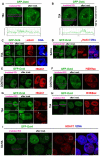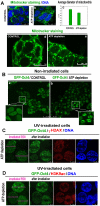Recruitment of Oct4 protein to UV-damaged chromatin in embryonic stem cells
- PMID: 22164208
- PMCID: PMC3229488
- DOI: 10.1371/journal.pone.0027281
Recruitment of Oct4 protein to UV-damaged chromatin in embryonic stem cells
Abstract
Background: Oct4 is a specific marker of embryonic stem cell (ESC) pluripotency. However, little is known regarding how Oct4 responds to DNA damage. Here, we investigated whether Oct4 recognizes damaged chromatin in mouse ESCs stably expressing GFP-Oct4. These experiments should contribute to the knowledge of how ESC genomic integrity is maintained, which is crucial for potential application of human ESCs in regenerative medicine.
Methodology/principal findings: We used time-lapse confocal microscopy, microirradiation by UV laser (355 nm), induction of DNA lesions by specific agents, and GFP technology to study the Oct4 response to DNA damage. We found that Oct4 accumulates in UV-damaged regions immediately after irradiation in an adenosine triphosphate-dependent manner. Intriguingly, this event was not accompanied by pronounced Nanog and c-MYC recruitment to the UV-damaged sites. The accumulation of Oct4 to UV-damaged chromatin occurred simultaneously with H3K9 deacetylation and H2AX phosphorylation (γH2AX). Moreover, we observed an ESC-specific nuclear distribution of γH2AX after interference to cellular processes, including histone acetylation, transcription, and cell metabolism. Inhibition of histone deacetylases mostly prevented pronounced Oct4 accumulation at UV-irradiated chromatin.
Conclusions/significance: Our studies demonstrate pluripotency-specific events that accompany DNA damage responses. Here, we discuss how ESCs might respond to DNA damage caused by genotoxic injury that might lead to unwanted genomic instability.
Conflict of interest statement
Figures








Similar articles
-
Acetylation-dependent nuclear arrangement and recruitment of BMI1 protein to UV-damaged chromatin.J Cell Physiol. 2012 May;227(5):1838-50. doi: 10.1002/jcp.22912. J Cell Physiol. 2012. PMID: 21732356
-
Acetylated histone H3K56 interacts with Oct4 to promote mouse embryonic stem cell pluripotency.Proc Natl Acad Sci U S A. 2013 Jul 9;110(28):11493-8. doi: 10.1073/pnas.1309914110. Epub 2013 Jun 24. Proc Natl Acad Sci U S A. 2013. PMID: 23798425 Free PMC article.
-
Transcriptional reprogramming and chromatin remodeling accompanies Oct4 and Nanog silencing in mouse trophoblast lineage.Stem Cells Dev. 2014 Feb 1;23(3):219-29. doi: 10.1089/scd.2013.0328. Epub 2013 Nov 7. Stem Cells Dev. 2014. PMID: 24059348 Free PMC article.
-
Chromatin regulation landscape of embryonic stem cell identity.Biosci Rep. 2011 Apr;31(2):77-86. doi: 10.1042/BSR20100089. Biosci Rep. 2011. PMID: 21091441 Review.
-
Role of Oct4 in maintaining and regaining stem cell pluripotency.Stem Cell Res Ther. 2010 Dec 14;1(5):39. doi: 10.1186/scrt39. Stem Cell Res Ther. 2010. PMID: 21156086 Free PMC article. Review.
Cited by
-
HP1β-dependent recruitment of UBF1 to irradiated chromatin occurs simultaneously with CPDs.Epigenetics Chromatin. 2014 Dec 30;7(1):39. doi: 10.1186/1756-8935-7-39. eCollection 2014. Epigenetics Chromatin. 2014. PMID: 25587355 Free PMC article.
-
Self-supervised pseudo-colorizing of masked cells.PLoS One. 2023 Aug 24;18(8):e0290561. doi: 10.1371/journal.pone.0290561. eCollection 2023. PLoS One. 2023. PMID: 37616272 Free PMC article.
-
PRMT1 arginine methyltransferase accumulates in cytoplasmic bodies that respond to selective inhibition and DNA damage.Eur J Histochem. 2014 May 2;58(2):2389. doi: 10.4081/ejh.2014.2389. Eur J Histochem. 2014. PMID: 24998928 Free PMC article.
-
Coilin is rapidly recruited to UVA-induced DNA lesions and γ-radiation affects localized movement of Cajal bodies.Nucleus. 2014 May-Jun;5(3):460-8. doi: 10.4161/nucl.29229. Epub 2014 May 23. Nucleus. 2014. PMID: 24859326 Free PMC article.
-
Determination of protein interactome of transcription factor Sox2 in embryonic stem cells engineered for inducible expression of four reprogramming factors.J Biol Chem. 2012 Mar 30;287(14):11384-97. doi: 10.1074/jbc.M111.320143. Epub 2012 Feb 9. J Biol Chem. 2012. PMID: 22334693 Free PMC article.
References
-
- de Waard H, Sonneveld E, de Wit J, Esveldt-van Lange R, Hoeijmakers JH, et al. Cell-type-specific consequences of nucleotide excision repair deficiencies: Embryonic stem cells versus fibroblasts. DNA Repair (Amst) 2008;7:1659–1669. - PubMed
-
- Niwa H, Miyazaki J, Smith AG. Quantitative expression of Oct-3/4 defines differentiation, dedifferentiation or self-renewal of ES cells. Nat Genet. 2000;24:372–376. - PubMed
-
- Shimozaki K, Nakashima K, Niwa H, Taga T. Involvement of Oct3/4 in the enhancement of neuronal differentiation of ES cells in neurogenesis-inducing cultures. Development. 2003;130:2505–2512. - PubMed
Publication types
MeSH terms
Substances
LinkOut - more resources
Full Text Sources
Other Literature Sources
Research Materials

